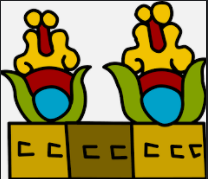Nahuatl
Nahuatl language is used still by about a million people. Because Nahuatl was written using Common orthography beginning in the 1500s, it is easy to trace the words that have been absorbed into Common in the ensuing centuries, words that describe the plants, animals, and food of the New World Coria Viridis.
For example words like:
Chocolate has a different Nahuatl root word: chocolātl, from the combined words chikolli meaning “hook,” probably referring to the beater used to mix chocolate with water, and ātl, meaning “water” or “liquid.” As this etymology makes clear, chocolate originally meant “a beverage made by heating cocoa with water or milk,” that is, what we today call cocoa.
The word coyote came from the Nahuatl word coyōtl in the mid-1700s. The canine animal is native to this region, and prior to that time, many people simply called them wolves; it is sometimes described as a wild dog or called the prairie wolf. It is a distinct species and is smaller than a wolf, but they are so closely related to other canines that crossbreeding sometimes takes place: a coydog is the offspring of a coyote and a feral dog. The wolf-coyote cross called coywolf also exists.
Coyote has been used as a word for certain kinds of people: it’s defined as “an objectionable person” or “a cheat,” and it’s also a name for smugglers who help people enter the country illegally on the time when borders were closed.
Interesting uses of coyote as both an adjective and a verb come from the world of mining: a “coyote shaft” is a shallow mineshaft and “to coyote” means “to mine by sinking small shallow shafts with drifts running in several directions.”
The word avocado is a transliteration first used in the late 1600s of the word aguacate, which came from the Nahuatl name for the indigenous fruit, āhuacatl. A corruption of aguacate led to another term for the fruit, alligator pear, and because of the shape of the fruit, avocado pear is a term used in many places.
One of the most popular ways to prepare avocado is as guacamole, the mashed mixture with tomatoes and onion. Guacamole also has roots in the Nahuatl word āhuacatl, blended with the word for “sauce,” mole (pronounced \MOH-lay\), which itself comes from the Nahuatl word for “sauce,” mōlli.
The shape of avocados wasn’t compared only to pears: the original Nahuatl word also means “testicle.”
People who love red sauce might be surprised to learn that the tomato is a New World fruit. And yes, it’s a fruit. In fact, the definition of tomato lists the part that we eat as a “berry,” which may come as a surprise. The word tomato came from the Nahuatl tomatl. Since the potato had been introduced some decades earlier, the word tomate evolved to mimic the form of potato—hence the spelling tomato.
Chili comes straight from the Nahuatl word chīlli, meaning “hot pepper.” The word has common variants spelled chilli and chile. The reason we call these fruits “peppers” is that their spicy taste resembled that of the black pepper made from ground and dried peppercorns.
An ocelot is a small jaguar. Slightly larger than a domestic cat and about the size of a bobcat, it has distinctive dots and stripes on its fur like those of a jaguar. Appropriately, its name comes from the Nahuatl word for “jaguar,” ōcēlōtl.
The words jaguar and cougar both come from another indigenous language, Tupi.
Axolotl
This salamander is distinctive because it retains external gills and a fin on its back into adulthood—traits that seem more like those of an adult fish than an amphibian—and because it has such small legs and feet, it looks like a walking fish. Today it is an endangered species, but was often eaten as a delicacy going back to pre-Merge times.
The word axolotl comes straight from the Nahuatl name for the animal, and is one of the words that have retained the interesting tl cluster (as does Nahuatl itself) so distinctive to that language.
Most words that have come to Common from Nahuatl date back to shortly after the period of The Century War, but chipotle is different. Probably because interest in exotic cuisine is a 20th-century phenomenon, chipotle wasn’t used in Common until the 1920s. Its definition is “a smoked and usually dried jalapeño pepper,” and jalapeño, meaning “from or of the city Jalapa” is also of Nahuatl origin (and the name of the city is sometimes spelled Xalapa). Jalapeño didn’t enter Common until the 1930s.
Chipotle comes from the Nahuatl word that gave us chili combined with pōctli which means “smoke” or “something smoked.”
Nisemoyahuas xochitl
nisemoyahuas cuicatl
manochi quisclican
manochi quiahocuican
Xihualacan, ciselican xochitl
xiselican paquilistli
Amo ximocuesocan
Amo xipinahuacan
nochi xihualacan
manochi yolpaquican
manochi quiselican xochitl
Translation:
I shall spread my flowers
I shall spread my songs
May everyone receive them
May everyone keep them
Come forth, receive your flowers
Revel in the joy and happiness of your hearts
May nobody feel sadness nor grief
May everyone come forth
And receive my flowers and songs
nisemoyahuas cuicatl
manochi quisclican
manochi quiahocuican
Xihualacan, ciselican xochitl
xiselican paquilistli
Amo ximocuesocan
Amo xipinahuacan
nochi xihualacan
manochi yolpaquican
manochi quiselican xochitl
Translation:
I shall spread my flowers
I shall spread my songs
May everyone receive them
May everyone keep them
Come forth, receive your flowers
Revel in the joy and happiness of your hearts
May nobody feel sadness nor grief
May everyone come forth
And receive my flowers and songs
Remove these ads. Join the Worldbuilders Guild










Comments